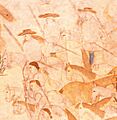Soldado de cuera facts for kids
The soldados de cuera (which means "leather-jacket soldiers" in English) were special soldiers who protected the borders of northern New Spain (which is now parts of the southwestern United States and Mexico). They served in special forts called Presidios from the late 1500s to the early 1800s. These soldiers were expert horsemen and were a unique part of the Spanish Empire's army. They got their name from the thick, multi-layered deer-skin coats they wore. These coats helped protect them from arrows used by Native American groups. When a Spanish inspector named José de Gálvez planned an important trip called the Portola Expedition, he chose 25 of these soldiers to go with him. He called them "the finest horsemen in the world."
Contents
What They Wore and Carried
The most important part of a soldado de cuera's gear was their leather jacket, called a cuera. This jacket was like a coat without sleeves and had many layers of deer hide. It was strong enough to stop most arrows, unless fired from very close range. For extra protection, they also used shields and leather leg coverings.
Their shields were made from two layers of tough bull hide. They carried these on their left arm, and they could block both arrows and spears. Leather leg coverings, or aprons, were attached to the front of their saddles. These protected their legs from sharp bushes and cactus spines while riding.
These soldiers carried many weapons. They had a carbine (a type of rifle), a pair of pistols, and a bow. For close combat, they used a dagger, a wide sword, and a lance (a long spear). They also carried a bull-hide shield called an adarga or a small, round metal shield called a rodela. These shields helped them defend against swords, spears, and arrows.
Each soldier owned several horses. They usually had six horses, a young horse (foal), and a mule. Before 1720, they even had ten horses! The soldiers had to buy all their own equipment and animals.
Who Could Join
These frontier soldiers were recruited from different groups of people. Many were Mestizo (people of mixed European and Native American heritage). Some were Native Americans who had adopted Spanish culture, and others were freed slaves. Most of the officers (leaders) were Criollos (people of Spanish descent born in the Americas). However, very few of the regular soldiers were Criollos.
Soldados de cuera worked in the presidios (forts) that stretched across a huge area. These forts went from Los Adaes in Louisiana, through Texas, New Mexico, and Arizona, all the way to the Pacific Coast of Alta California (modern-day California).
There were always enough people who wanted to join. Most recruits came from the local areas. They were used to the climate, were excellent horsemen, and knew the land well. For many poor people, becoming a soldado de cuera was a good opportunity. They received regular pay, medical care, and even the chance to get land or promotions.
What They Did
When they weren't fighting against Native American groups, the soldados de cuera had other important jobs. They would escort groups of travelers or protect wagons carrying goods. They also had to guard the huge herds of horses and mules that belonged to the forts. A fort with 50 soldiers might have over 500 horses and mules! This constant guarding meant fewer soldiers were available for other tasks.
The Villasur Expedition
In August 1720, a group of about 40 soldados de cuera went on an exploration trip into what is now Nebraska. They were joined by Native American allies. However, they were ambushed by Pawnee and Otoe tribal groups. Most of the Spanish soldiers were killed, with only a few escaping. This defeat showed that the Spanish could not easily expand their control further east into the Great Plains.
How They Were Organized
In Santa Fe, the governor of Santa Fe de Nuevo México was also the captain and leader of the dragones de cuera company. He usually held the rank of Lieutenant Colonel.
Under him, there were two lieutenants. The first lieutenant was often also a captain. There were also two sergeants and six corporals. The rest of the company were privates. Among the privates, there was usually an armorer (who fixed weapons), a drummer, and six carabineers (soldiers who used carbines).
Special groups called compañías volantes (flying companies) were created in 1767. These were like a mobile reserve, ready to move where needed. They had the same equipment as the regular companies. Later, in 1778, tropas ligeras (light troops) were formed. These soldiers did not wear the heavy leather armor, shield, or lance. Their hats were white, and they were otherwise equipped like regular soldados de cuera. A light troop company usually had 19 soldiers.
Images for kids
See also
 In Spanish: Soldado de cuera para niños
In Spanish: Soldado de cuera para niños




